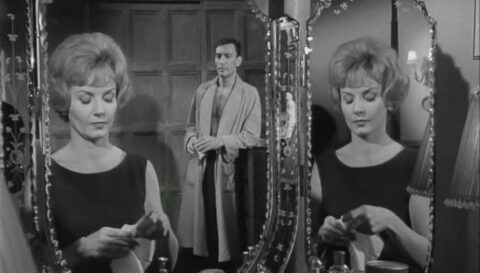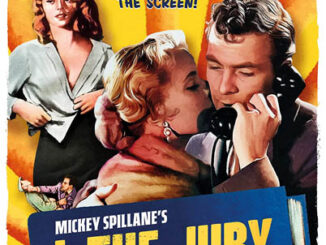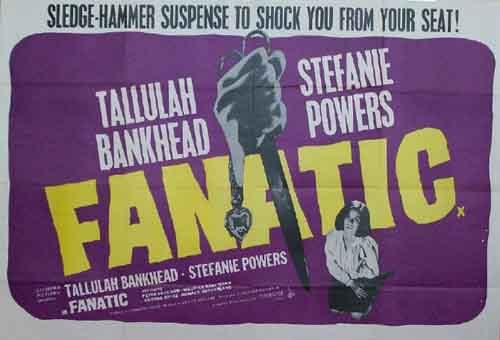Night of the Eagle (1962)
Directed by: Sidney Hayers
Written by: Charles Beaumont, Fritz Leiber Jr, George Baxt, Richard Matheson
Starring: Anthony Nicholls, Janet Blair, Margaret Johnston, Peter Wyngarde
AKA BURN, WITCH, BURN
UK
AVAILABLE ON BLU-RAY: NOW, from STUDIOCANAL
RUNNING TIME: 92 mins
REVIEWED BY: Dr Lenera

Professor Norman Taylor seemingly has it all: a great job, the envy of his colleagues, a happy marriage, and a healthy scepticism when it comes to the supernatural. However, he discovers that his wife Tansy has been practising witchcraft. She insists that her charms have been responsible for his rapid advancement in his academic career and for his general well-being. Norman is angered by her acceptance of superstition and forces her to burn all her magical paraphernalia. Almost immediately things start to go wrong….

You’ve got to love it when rigidly disbelieving academics are forced to confront the idea that there ARE more things on earth than are dreamt of in their philosophies. Quite possibly the best film where this happens is 1958’s Night Of The Demon, a true classic of horror which is one of those films which I keep intending to do a review of [if partly because I want to defend the monster; fans of the movie will know what I’m on about]. but never seem to have the time. But for now we have Night Of The Eagle, made five years later, which has a lot of similarities. Sidney Havers’ supernatural chiller isn’t quite the masterpiece that Jacques Tourneau’s is, but it’s still very impressive, and does most certainly best the earlier movie in one respect; Peter Wyngarde and Janet Blair are far better in their leading roles than Dana Andrews and Peggy Cummins were in there’s, and they probably had to be, because much of the focus is on this married couple whose marriage suddenly derails when husband discovers that wife has been hiding a lot from him – a lot. Elements of the workplace drama are skillfully melded with a chiller that builds excellently in its early stages and then reaches some impressive peaks of fright, the fast paced narrative hurtling towards a climax which is exceptionally technically well pulled off for what was a pretty low budget effort for the time. Fritz Leiber Jr’s novel Conjure Wife had already been filmed in 1944 as Weird Woman, an even cheaper Universal programmer starring Lon Chaney, which is certainly a decent effort, but this second go at the material is clearly the superior picture, even though I really like the way Weird Woman maintains an ambiguity right to the end, the tale working rather well that way. This one kind of eventually gives up on any kind of “did this happen or did it not happen” ? stuff.
Richard Matheson and Charles Beaumont wrote this second adaptation and stuck closer to the book, though they still significantly streamlined the story, in particular removing most of the subplots about possession and people ending up in other’s bodies. American International Pictures passed the project over to their regular co-producers, Anglo-Amalgamated in England, which is probably why the setting was changed. They agreed to finance, allocating the movie to Independent Artists to produce, who bought in George Baxt to do a few alterations on the script. Peter Cushing was asked to star, which would truly have been great, though, despite me loving him greatly, I doubt very much that he would have been as good as Wyngarde. Sources differ as to why Cushing didn’t do the film. He was either ill, or he chose to be in Hammer’s Captain Clegg, a project he clearly loved seeing as he stated that he wanted to play his character in that again. There are also rumours that Peter Finch was offered to star as well. In any case Wyngarde was cast at the last minute, and even he passed then saw a luxury car that he desperately wanted to own, so he went back and took the role, asking to be paid exactly the amount for the cost of the car. Filming took place at Taplow Court in Buckinghamshire, Porthcurno and Pe dn Vounder Beach in Cornwall, and Elstree Studios. While shooting the scene where the Taylor house burns down. Janet Blair received a phone call that her actual house was on fire. Film prints for the US release were retitled the much more direct Burn, Witch, Burn, a line spoken in the film, and preceded by a narrated prologue in which the voice of Paul Frees was heard to intone a spell to protect the audience members from evil. For protection, American cinemagoers were given a special pack of salt and words to an ancient incantation. Night Of The Eagle did well at the box office, especially in its US incarnation. There was a third version, played for comedy, in 1980 called Witches Brew or Which Witch Is Which?
The titles occur beside a shot of a lady’s eye, after which we get the first of many shots of the eagle statue of Hempnell Medical College, it constantly being an ominous presence. The opening shot moves left to take in the main gates and the building itself before alighting on a car driving in. The heard words “I do not believe” are also seen written on a blackboard by our disbelieving hero, who announces that things such as “witchcraft, superstition, psychic etc” are “morbid desire to escape from reality”, He even mentions the stupidity and uselessness of things people may wear for protection, saying how a pilot who took some of his wife’s hair with him was killed nonetheless. We’re also introduced to two other characters; student Margaret Abbot, who has a crush on Norman, and her boyfriend Fred Jennings who Norman thinks is seriously slacking though Norman believes that Norman is picking on him. Things are nonetheless good for Norman, who’s moving up and up at the school, though he’s doing it so fast that his co-educators are rather jealous, including one in particular, Flora Carr, the wife of Lindsay Carr. A scene where the two are round the Taylor house for bridge, are full of references to things like “phony black magic”, “hypnotism” during a game of bridge and “you sold your soul to the devil” which come across as rather forced and overly obvious, though of course someone owning a black cat doesn’t automatically mean anything, does it? One evening Tansy Taylor is increasingly agitated when she can’t find something. Norman helps and finds a dead spider in a tin, just a souvenir from their holiday in Jamaica, according to Tansy. Later that night he finds, in a very well handled little moment where a lampshade spins to then reveal it stuck there, a charm hanging. He burns it to ashes with his cigarette lighter, but hold on; Tansy has loads of the things in drawers, and the next day she comes home from work to find them all over the dining room table.

“Well isn’t it obvious I’m a witch”? she says, to receive the reply “I can’t believe it, a woman of your intelligence”. She says how they’re hated where they work, then describes how it all started two years ago in Jamaica. Weird Woman possibly has another one up on Night Of The Eagle by showing this as a proper flashback, but then again just having Tansy talk about it was possibly one of the alterations made by Havers to have less focus on weird things. Apparently Norman almost died, but when she watched a girl being brought back to life [which he of course says was just a trance] and an old lady dying in her place, she made some kind of pact to have her husband not just get healthy again but be successful. He forces her to burn all her stuff, despite her saying “I will not be responsible for what happen if you make me give up my protection”. She’s especially unhappy when he throws in the fire a small photograph of him, and neither is the cat who then disappointingly disappears from the proceedings. And immediately trouble begins, in a really masterful section which gets more and more intense as things get worse and worse. Margaret rings him up and whispers sexual overtones; a spider is on the carpet; Norman is almost ran over by a van; Fred gets more threatening; Margaret tells people that Norman raped her; the lights in the house go out and, in a genuinely frightening bit, there’s seems to be a monster growling at the front door, the camera zooming into the door handle being enough. Then Tansy disappears. His searching maybe takes a little too long, but the tension only slightly diminishes, the revelation of the true villain is a nicely written scene where the slowing down of the pace works very well for the movie, and the final is pretty exciting. Apart from one hugely visible wire, the combining of shots of a real eagle on small sets and quick shots of model work and a glove puppet can only be admired.
The plot has one thing which doesn’t really hold water; why doesn’t Tansy tell Norman that a certain somebody is up to something. Surely it would be a good idea for more than one reason? Actually, come to think of it, I also can’t work out why a recording of Norman’s voice should be able to do what it is does near the end, but maybe not explaining all of the magic was intentional. Margaret and Norman disappearing is also a shame; I’d have liked to have seen them around for a bit more. There are hints as to there’s being a very dark and interesting relationship, but they’re just slight hints, in a film which handles its subject matter with as much subtlety as it can take, actually feeling like a Val Lewton effort for much of the time. And, despite the scare sequences, which also include Hayers restaging a bit from Vampyr, perhaps the most uncanny bit is a single shot of Tansy walking oddly, a shot which makes us jump or shudder, and not just because it causes Norman to suddenly realise something very important. Of course what we’re seeing more than anything else is a man’s journey from fervent, confident dismissal of the supernatural to loss of faith and absolute belief in something completely different, not to mention total and utter terror [though understandably real terror that was real when fleeing from a real eagle]; and all this is superbly shown in Wyngarde’s fantastic performance. Perhaps the hardest scene he had to pull off was when his character, after rubbishing the existence of the supernatural for ages. By contrast Blair is less strong, rather overdoing being neurotic, though she and Wyngarde really do come off well as a screen married couple, with a good amount of chemistry. I can see a modern version working which gives the wife as much prominence as the husband or makes the husband a secondary character. It certainly wouldn’t have the somewhat sexist attitude to “emotional” females who first of all believe in witchcraft and secondly use it for supposedly good reasons.
Also memorable out of the cast is Margaret Johnson as the eccentric teacher Flora Carr, with her twitchy, cat-like mannerisms, while there’s plenty of style in Havers’ direction, where foreground and background often contrast or even interact in different ways, and Reginald Wyer’s cinematography which likes odd angles and strange points of view while Ralph Sheldon’s editing sometimes employs some jarring edits, such as a cut from Norman looking over a beach for Tansy to a closeup of one of Tansy’s eyes. A particularly stylised scene is when Tamsy is waking up in a bed and we adopt her point of view, seeing two men constantly look at her while the edges of the frame are blurred. It’s very well pulled off, even if perhaps rather incongruous seeing as nearly all of the film is from Norman’s point of view. Director Sidney Havers did few other films, his only other horror being the decent Circus Of Horrors, and spent most of his career doing TV, but judging by what he achieved with Night Of The Eagle that was a considerable waste, and one wonders what happened. He could have become a major horror director, though saying that, perhaps the greatest genius of Night Of The Eagle is that you could remove the admittedly exciting climax, which I imagine some people don’t like because it makes totally explicit the supernatural, and tweak the story just a little so that the witchcraft isn’t real at all – and it would still work.
Rating: 









Studiocanal have touted this release as being a new restoration, so this is probably not the same one as Kino Lorber’s in the United States, or indeed Imprint’s in Australia, both of which had the American prologue attached. Exact details don’t seem to be available, but I can tell you without a doubt that Night Of The Eagle looks superb here. The picture is very crisp without any signs of artificial sharpening, with grain extremely evenly managed. The blacks are just gorgeous. A sign of how well this film was made is that I didn’t notice before [incredibly I only first saw this minor classic around two years ago] that a couple of shots featured matte work; it was so well done that only High Definition made it obvious. On the other hand I couldn’t tell any signs of print damage whatsoever. Terrific!
SPECIAL FEATURES
Archival Audio Commentary with screenwriter Richard Matheson
Studiocanal lose four featurettes from the Imprint Australian Blu-ray release but retain this audio commentary which appeared in a 1995 Image Entertainment Laserdisc but wasn’t reused until 2015 for the US and Aussie releases, for some reason. Matheson has a lot of gaps and sometimes forgets details, such as not always being sure whether some details were in the novel or not, though we get a few things, such as realising that a line of his had been altered, and his seeming relative lack of preparedness has its own charm. I still really enjoyed listening to a writer I feel has been largely undervalued. I found it poignant when he said that Somewhere In Time, a personal favourite of mine, was the only film based on his work which invited him to be involved. Along the way he talks a lot about working on the Corman / Poes – Basil Rathbone saying that his sword fight in The Adventure Of Robin Hood took three days to shoot while making a film which only took three weeks to shoot is great – which may be that related to Night Of The Eagle but will delight horror fans; he also describes of the process that he and Beaumont had, with the latter taking over after Matheson had done the first half, We can agree that too much credit is often given to the director of a film, especially when writers like Matheson describe stuff like camera shots in their screenplays, and we can also wonder at how good a Hammer film of I Am Legend might have been. The elderly Matheson is extremely laidback, but is most definitely worth making an effort to listen to.
Burn Witch, Burn: Anna Bogutskaya on “Night of the Eagle” [24 mins]
This new featurette features a new [presumed] film writer to these things instead of the usual faces, though Bogutskava has already established herself as a critic who likes to write from a feminist point of view. And she sees a lot of note in Night Of The Eagle, which to her is radical for the time in showing a marriage where the man and the woman are both interesting characters who respect each other as equals instead of the “usual suburban stereotypes”. She also notes bow not just one woman but two women essentially build foundation for their men, and how there are two things going on in many scenes, such as when Tansy is looking for her lost totem she’s also trying to see if Norman finds something else, as well as seeing the film as showing the horror in suburbia in the manner of some of David Lynch. This is a very fine piece with a lot to chew on.
Archive Interview with Peter Wyngarde [24 mins]
From both the earlier Blu-rays comes this really rather great interview with a candid Wyngarde, who rubbishes some of the supernatural stuff which ended up being taken out. He also says how Blair kept looking at the camera which took him some getting used to. Though his best story is when he, Alan Bates and John Schlesinger went to the premiere of Night Of The Eagle and nobody else was there. Being a massive lover of that film, I was also delighted to hear him talk about The Innocents, on the set of which he actually played a ghost where he was unseen but stood behind a curtain so that Deborah Kerr could feel a genuine presence and pull off a scene. A few other credits are mentioned too, in a career which never really fulfilled it potential.
US Theatrical Trailer [2 mins]
UK Theatrical Trailer [2 mins]
US Alternate Opening Credits [2 mins]
Melodramatic and unnecessary but fun.
Behind the Scenes stills gallery
Four art cards
“Night Of The Eagle” is taut, scary and just a bit thought-provoking. Studiocanal’s release belongs in any horror lover’s collection. Highly Recommended.





Be the first to comment